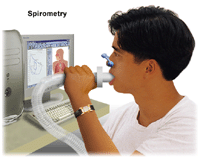Bronchodilator Reversibility Testing
Bronchodilator Reversibility Testing
What is a bronchodilator reversibility test?
The bronchodilator reversibility test is used to determine how well your lungs are working.
This test uses a spirometer and a bronchodilator. A spirometer is a machine that measures lung function. It measures how much and how fast air is blown out or exhaled. Bronchodilators are medicines that open the airways, making it easier to breathe.
Why might I need a bronchodilator reversibility test?
This test is often used in people who have asthma or chronic obstructive pulmonary disease (COPD). For example, it may be done to help diagnose either condition.
How do I get ready for a bronchodilator reversibility test?
Before the test, you may be told not to take your usual bronchodilator medicine. Make sure you follow the instructions exactly as given.
What happens during a bronchodilator reversibility test?
This test is often done in your healthcare provider's office. The reversibility testing steps usually include the following:
1. You will be asked to take a deep breath and then blow into the mouthpiece of the spirometer as hard as you can. This is a baseline measurement. The spirometer records the results.
2. You will be given a dose of bronchodilator medicine using an inhaler or nebulizer.
3. You will wait for about 15 minutes.
4. You will take a deep breath and then blow into the mouthpiece spirometer as hard as you can. Again, the spirometer records the results.
5. You will be asked to blow into the mouthpiece more than once to get the best reading possible.
What happens after a bronchodilator reversibility test?
Your healthcare provider will make, confirm, or exclude a diagnosis of lung disease by using information about:
Your medical history
Findings of a physical exam
The results of this and other tests
The information may be used to determine the severity of your lung condition and to help figure out the best treatment for you.
Updated:
March 21, 2017
Sources:
2016 GINA Report, Global Strategy for Asthma Management and Prevention. Global Initiative for Asthma., Mason: Murray and Nadel's Textbook of Respiratory Medicine. Mason, R. 2010, ed. 5, p. 529., Ortiz, Gabriel. Focus on Asthma and COPD. A Practical Guide to Interpreting Bronchodilator Reversibility in Chronic Obstructive Pulmonary Disease (COPD), 2012, issue 5., Spirometry Testing in Occupational Health Programs Best Practices for Healthcare Professionals. OSHA.
Reviewed By:
Blaivas, Allen J., DO,Holloway, Beth Greenblatt, RN, M.Ed.
